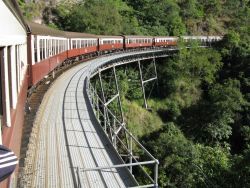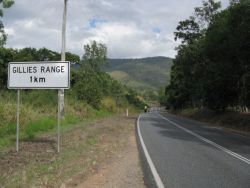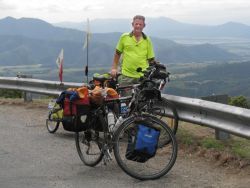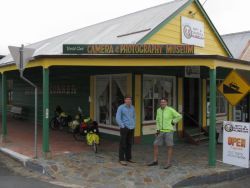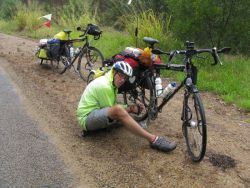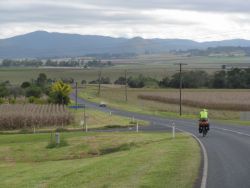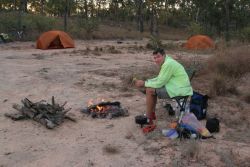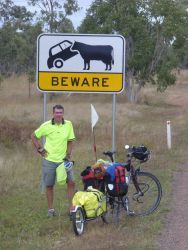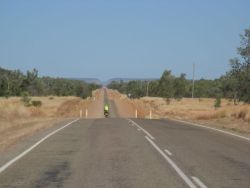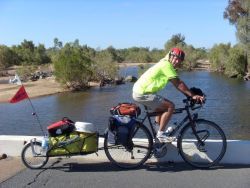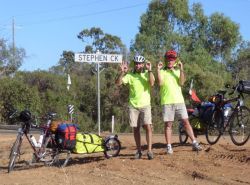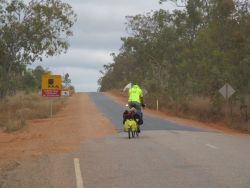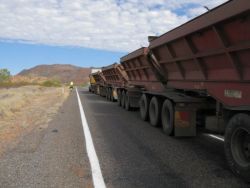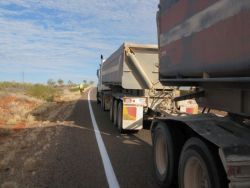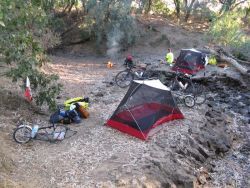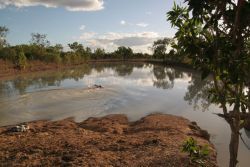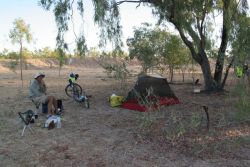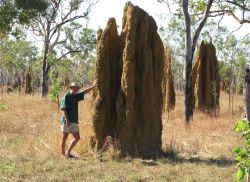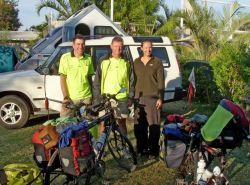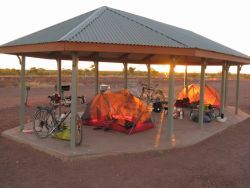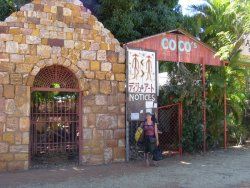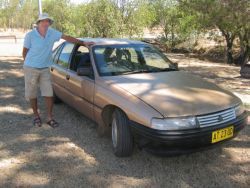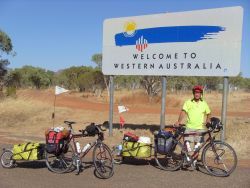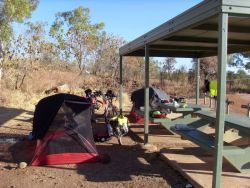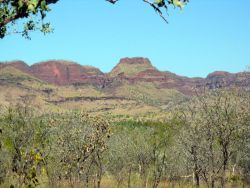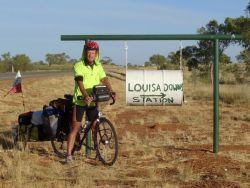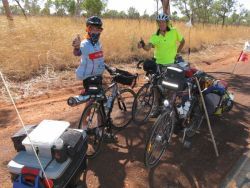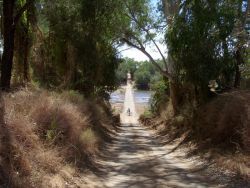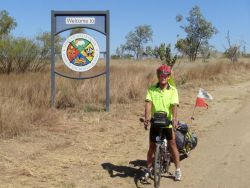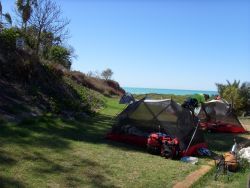From Cairns we headed up and over the range into the Atherton Tablelands and finally into the outback. Originally the plan had been to go through Normanton and follow the Gulf of Carpentaria around to Borroloola and Roper Bar (as a cyclist called Lunky had done in 2003), but it transpired that our bike and trailers were unsuitable for the sandy dirt roads in that area. We still went via Normanton but headed south for four days to Cloncurry where we again headed west towards the Stuart Highway and eventually Broome.
(click on any picture for a larger version)
Candidate for worst day of the ride #1
Given that we were away for 216 days, there were remarkably few days when the riding wasn’t actually enjoyable. The ride from Atherton to Ravenshoe a couple of days out from Cairns was the first candidate for a genuinely unpleasant day.
Leaving Atherton we missed a turn-off to the main highway and ended up going on a different road than the one we had planned. We were about 8kms down this wrong road when it became obvious the road markers bearing the letter H did not compute with what we should have been seeing. A quick check of the map showed that we were going in the right direction, but via back road through a town called Herberton. No big deal we though and continued pedalling.
Soon after the road began to climb, and climb, and climb and we were struggling to maintain 6km/hr and still every turn revealed more climbing tarmac, this went on for what seemed an eternity, and eventually after climbing into the cloud layer the road levelled and became undulating. Although the climb out from Cairns had been higher and longer, this climb was steeper and unremitting, and was the hardest pedalling of the ride so far.
A reasonably gentle descent into Herberton followed, then a short sharp steep climb into the main street, and we were able to relax in what turned out to be a pleasantly interesting mining town, complete with a world-class photography museum.
Despite the attractions of Herberton we were determined to make Ravenshoe so after lunch we headed south east to rejoin the main road to Ravenshoe, and immediately the road became a non-stop series of short sharp downhills followed by crawling ascents, and the showers started, brought in by a gusty SE wind. The day became an alternating pattern of 5-6km/hr climbs for 10 minutes or so, followed by all too brief rushing descents at 30-40km/hr, followed by another climb and so on, all the time with a blustery rain coming and going.
Eventually after a couple of hours of this most uncomfortably hilly road we rejoined the highway and although it was also undulating, at least the gradients were manageable. The closer we got to the coast, the stronger the easterly wind became. We emerged from the protection of the bush into open paddocks with maybe 15km to go, and after doing battle with 40km/hr winds we came across a wind farm with a few dozen roaring towers enjoying the conditions that we found most unpleasant. Somehow the beating blades of the towers lulled us into feeling a bit better about the wind and we enjoyed a few minutes watching the raw power at work.
Luckily the final section of the road into Ravenshoe turned SW and we did get to enjoy a 50km/hr 5km long downhill run to finish off the day. Despite that and the attraction of having dinner at Australia’s highest pub, the day still rates as the most unpleasant, if not quite the hardest or most frustrating.
Overcoming a mental hurdle
Heading into the outback proper was something I faced with a degree of trepidation. Even though I had partly grown up in remote places I was not at all confident that the isolation would not get to me. I had visions of feeling agoraphobic or getting a sort of homesickness for the relative hustle and bustle of the populated east coast.
However, virtually as soon as we headed out from Ravensthorpe into the scrub, and with the road disappearing into the distant horizon, and just the two of us pedalling through the enormity of the landscape, I started to feel comfortable. The occasional passing road train or caravanner provided a reminder that we were not completely alone, and after the incessant traffic we had left behind the long almost silent pauses between passing vehicles was pure heaven.
So despite my fears there really was no hurdle to cross and I actually started to feel at home in the isolation within a day or so. The only downside to the country around Normanton was its mind-numbing sameness, most other roads have some vistas and changing vegetation types, but not the gulf country. When we finally came into view of the hills around Cloncurry it was as though we had been transported to a different country, one with variety in the scenery!
Ettiquette of the single lane tar roads
Much like in the animal kingdom, a pecking order exists on the outback roads west of Ravenshoe, through to Normanton. For a declining number of stretches, most about 20km long at a guess, there is a single shared lane of tar, and when two vehicles wish to share the same bit of road, it is customary for each to put one wheel onto the dirt shoulder and keep one wheel on the tar.
There is one rather obvious exception to this rule of the road, and that applies to any truck and trailer combination. From semi-trailers through to road trains. Those large and unwieldy machines need only move from the centre of the road when faced by a similar or larger sized vehicle. All other traffic, cars, utes, Commodores towing 24 foot caravans, Winnibagos, and bicycles all have to get right off the tar and allow the bigger trucks right of way.
So, you would assume that the same principles would apply to bikes when cars, utes, caravans etc were overtaking or passing. Wrong! We decided that the bicycle and trailer combination qualified as a rightful user of the tar, and we only got off the tar for large trucks. It was quite amusing sometimes to see grandpa towing the luxury caravan towards us, thinking we would move off the tar onto the bumpy cracked and often slippery shoulder, and realising at the last moment we weren’t going anywhere, and gnashing his teeth as he had to drop one of his precious set of polished wheels onto the dirt as the road rules specified and get his pristine chariot just a little more dusty than when he finished carefully washing it at the caravan park that morning.
Cane Toad Camp
After turning west into the outback, settlements were few and far between and it was necessary to bush camp on the longer stretches between town. We relied on information in a couple of touring cycle guides for pointers to suitable off-road areas to pitch the tents. West of Croydon was one such opportunity, and just after 100kms, with the sun getting low in the sky, we consulted the guide. There was mention of an overgrown bush track not far along, but as best we could determine, it wasn’t really a suitable site any more. I headed down another overgrown track to have a looksee and found an old crossing over a dry creekbed, that although not ideal it was assessed as good enough.
We set up camp with the tents on the old but broken concrete crossing, lit a small fire in the sandy creekbed, and after a slap-up dinner of tinned fish, rice and a cuppa, sat around enjoying the transition to the dark of the outback night. All of a sudden a slight rustle followed by a plop, then another, and the light of the head torches onto the jumble rocks and concrete of the crossing revealed a couple of cane toads, then another few, and soon the creekbed was literally covered in a mass of rustling and plopping cane toads heading out from the security of the rocks into the cool night air.
Our enjoyment of the scene quickly waned and we headed for our tents, where the mesh sides would keep the slimy little varmints at bay. Despite knowing that they couldn’t get into the tent, and weren’t going to damage anything left outside, I got very little sleep that night, as every little rustle in the dry leaves and tussocks was enough to put me on alert, partly because there were sounds of livestock about and in the haze of almost-sleep any sound was disturbing until its source verified.
When we pulled into the creekbed crossing there were absolutely no clues anywhere that the place was cane toad heaven, and yet there would have been well over a thousand of the disgusting creatures that emerged after sundown to add their peculiar sense of charm to the isolation of the outback. It probably rates as the worst bush camp of the trip, and comes second only to the gross fruit-pickers caravan park at Bundaberg overall.
 |
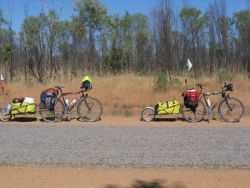 |
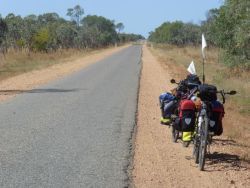 |
|
Welcome to Capricornia a large area with a rather small population |
Everything in our lives encapsulated |
In front or behind the view was the same in the gulf country between Ravenshoe and Normanton |
Friendly welders… NOT
We stopped to boil the billy just inside the gates to the Undara lava tubes not far from an advertising billboard which was only half erected. Not long after, a truck carrying the second half of the sign pulled up followed by an old Landcruiser, and a couple of blokes got out and started getting the welding equipment ready. Being friendly sorta chaps we wandered over at said g’day, and these two outback types made it pretty obvious we weren’t welcome. A curt grunt was all the reply we got to an offer to help them unload the sign, and a total lack of acknowledgement of our presence thereafter confirmed our perceptions. Perhaps they thought we had no place in their outback with our city-slicker transport, and good luck to them if that was all, but they still stand out as the two single unfriendliest coots we encountered in all 16,000kms of the ride.
Black Bull Siding trumps Sarina
Between Croydon and Normanton the cycling guidebook recommended Black Bull Siding as a good place to overnight. It was ideally placed about 100km from Normanton and we were looking forward to a shower and somewhere to sit around in comfort. I rode up a minute or so behind Pete to find him engaged in conversation with the lady running a rather ramshackle collection of tin sheds that passed for an accommodation precinct.
“Nah mate, ya can’t camp ere there’s no hot water” was the message. We agreed that cold water would be fine. “Nah mate no cold water neither” was the next excuse, despite the fact we were standing in the middle of half a dozen lawn sprinklers going full-bore. Nothing we could say would convince this dried-up old biddy to give us accommodation, and she suggested that we would be quite comfortable 500m down the road at what’s called a ‘borrow-pit’, or a large rainwater filled trench left when the road makers needed to ‘borrow’ dirt to build up the road corridor.
We left feeling a bit unloved and dejected and made our way to the borrow-pit and camped a good 400m off the highway. After a wash and swim in the pit, a billy and some dinner, our bush camp site didn’t seem so bad and we had a good sleep. It’s still hard to fathom why a place that offers accommodation decided we didn’t qualify for their salubrious facilities, and we will probably never know.
Hyprocritical ‘conservationist’
Between Camooweal and Barkly Homestead we stopped at a rest area for the night’s rest and got talking to a bloke from near Port Hedland who had converted his camper truck to run on sump oil. It was interesting to see the setup, with a special area for filtering the sump oil and removing water traces etc, and how he carried hundreds of litres in a trailer in fish shop oil containers, all free of course. He claimed he was driven by a conservationist ethic, doing his bit for the planet and all that, and we retired to the tents feeling a little better that at least someone was also being environmentally responsible.
Then, next morning, this greenie conservationist imposter drove off, hauling his trailer full of sump oil, and waving to us, and we waved back still full of admiration for his conservationist ethics, until we looked at the spot he had occupied for the night. Not only was there a large patch of oil where he had simply emptied out his filtration system onto the ground, but at the nearest bin he had left about eight 20 litre plastic drums that he had emptied, and just left for the road crews to deal with.
Turns out he was in no way interested in the environment, and I think he was just a tight-arse whose sole aim was to save money. Standing there looking at his reputation irrevocably tied to the mess he had left, we agreed he was a jerk of the first order.
Pathetic poms
As we pedalled the roads and tracks of northern Australia we were constantly amazed at the variety of grey nomads. A minority of these perpetual travellers were interesting folk who enjoyed an alternative and semi-active lifestyle away from their suburban roots. They tended to have unobtrusive caravans or camping trailers and would set off for a walk somewhere after quickly setting up their digs for the night. If you could tie them down long enough for a chat they would have interesting stories of remote places to share and were often slightly envious of our cycling adventure.
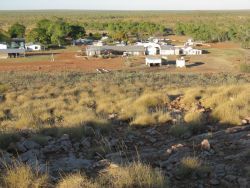 |
|
Banka Banka Station,
NT. Caravanners are |
However, the vast majority of this mobile population were simply trying to be fashionable and keep up with the Joneses in their own way, sticking to the established sights and having a good time in caravan parks along the tar-sealed roads. You could normally pick these ones by their satellite dishes and large Jayco caravans. After carefully setting out the latest in awning furniture they would seek out other similar caravanners to while away the empty hours with endless tales of dirt roads conquered and accessories lovingly purchased. Occasionally a representative would be sent over and pretend to be be interested in our cycling adventure but would quickly turn the conversation to the hardships of their travails in sharing the roads with nasty big trucks, and the odd one would offer us advice on ways to avoid contact with the indigenous peoples.
Then there were the pathetic poms and their ilk. Worn out old unionists and machine tool operators who, having spent most of their miserable lives in an industrial wasteland, drinking beer and following the horses, were determined to follow their neighbours into the great wide unknown. Having mortgaged or sold the three beddie fibro cottage in Port Kembla or Werribee, they often had the latest and greatest 4WD towing a Jayco Expanda kitted out with a generator and satellite dish so as not to miss Today Tonight while in the outback. To prove their independence from the comforts of civilisation, and armed with the latest copy of the free campers atlas, they would leave their chosen off-road rest area mid-morning, and travel a couple of gruelling hours to the next rest area, where they parked as close as possible to whatever meagre facilities were on offer such as a concrete table or small area of shade.
After securing the prime spot in the rest area, they would generally sit around under the shade of an annexe, drinking VB and waiting patiently for the next grey army representative to roll up, and wallow in the glory of their prime position in the lonely dust-ridden fly-blown rubbish-strewn off-road rest area, while the other later arrivals had to make do with the outer spots. As soon as The Simpsons came on they would huddle inside, generator whirring away, then emerge to play cards or sing tuneless versions of Tom Jones classics with other members of their clique.
At one stop, near Newcastle Waters in the NT, after cycling 115kms, we had secured a reasonable spot in a busy rest area, next to a table and chairs, a little away from the main mob of caravanners, and looking forward to a comfortable dinner and sleep. Tents were up, bicycles were arranged to keep at least a small buffer zone around us, but the message was lost on a pair of pommy couples. In accents reminiscent of the criminal classes portrayed in The Bill, they parked their oversize caravans slap bang as close as possible to our carefully chosen site, and made it obvious in an obnoxious way that they were definitely working class. I muttered a comment about their generator disturbing what had been a peaceful environment at one stage, and it was as though I had insulted the prophet Mohammed in front of a muslim. After enduring half an hour of whining cockney catcalls and their generally obnoxious presence only a metre from my tent, I moved up to a spare patch of gravel up the other end of the rest area, as it was obvious it was the only way to ignore them. Pete’s tent was on the other side of the rest area table, so he wasn’t as overwhelmed and chose to stay, despite being constantly baited by the louder of the pommy couples until he retired to the tent.
The experience at Newcastle Waters was not typical, however overall we gradually became more and more jaded with the overwhelming gulf between our interests and those of the caravanning population, and we consciously began to avoid contact with most of the grey army for the rest of the trip.
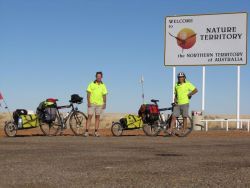 |
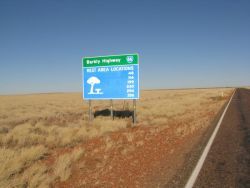 |
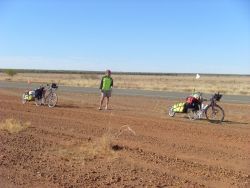 |
|
Pete's first time in the Northern Territory |
You know you have to keep pedalling when you see signs like this |
In the middle of the big emptiness |
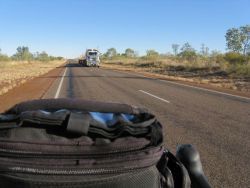 |
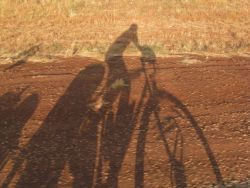 |
 |
|
The view over the handlebar bag |
Sometimes all you have for company is the faithful morning shadow |
Daly Waters pub is a full-on tourist stop but still good fun and had a welcome swimming pool |
Coco’s at Katherine
During the preparations for the trip we discussed the merits of riding to Darwin from Katherine, which would have meant returning on the same piece of tar in order to head west, as there are no serviceable roads west from Darwin to the Kimberley. This didn’t seem to make a lot of sense so we were happy for Katherine to be the most northerly point in the NT for our bikes, if not for us. We were going to Darwin to check it out and do a Kakadu tour.
Which meant that our bikes needed somewhere to stay while we were away. Several people we had met on the way had recommended a place called Cocos, a backpackers that catered for cyclists apparently. So, on arrival in Katherine, we dutifully made our way to 21 First Street and entered the hallowed ground through the gated stone wall. Inside was a ramshackle back yard full of tents, a couple of vehicles, an aboriginal craft area, all behind a slightly run-down house, with young travellers milling about doing their thing. After the overpowering sameness of the caravan parks and the grey army that we had endured for over 3000km this was heaven.
Coco, the owner, was a down-to-earth fellow who we instantly felt at ease with, totally unpretentious, friendly and yet a shrewd operator, and helpful to boot. After we had expressed an interest in hiring a car for the trip to Darwin, and having seen us crestfallen at the rip-offs being demanded by the local firms, he offered us the use of his ‘indigenous style’ Commodore for half the price of the big boys down the road. Actually although ten years old or more it got us to Darwin and back in style. The strangest thing was setting off from Katherine on the open road, we found it difficult to get over 60km/hr initially as the scenery was just whizzing by, however through sheer bravery we soon got up to 100km/hr and after a few more km highway speeds felt normal again.
The stop in Katherine was definitely one of the highlights of the ride, partly because of a 4WD trip we had booked to Kakadu, but mainly because of the relaxed nature of Coco’s. Once inside the gates the atmosphere was so different to the caravan parks we had become used to, the endless questions from the grey army followed mostly by heroic tales of roads travelled whilst towing etc. The backpackers who chose Coco’s were travelling for the pure love of it, not because they had the latest Winnebago or Jayco caravan to show off to all and sundry. When we headed out towards the Kimberley we felt spiritually as well as physically refreshed as a result.
 |
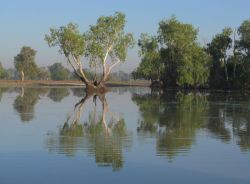 |
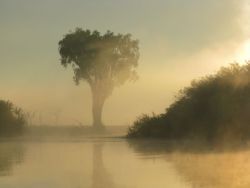 |
|
Sun's gone down, dinner's been had, must be time to turn in, it's nearly 8pm after all |
Kakadu |
Kakadu |
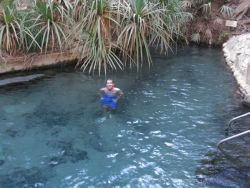 |
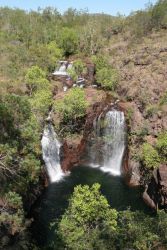 |
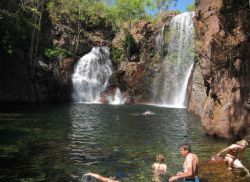 |
|
Swimming in the 'hot' springs at Mataranka in water at just 31 degrees |
Litchfield, the other Kakadu |
While Litchfield was a lot smaller than Kakadu it had more swimming holes |
Pete’s amazing magic mobile phone
Not more than half a day’s ride out of Katherine, (or 30 odd minutes by car) I was lost in a world of tallish timber punctuated by the occasional clearing filled with VB bottles and cans in staggering quantities, when up ahead I noticed a car off the road and four figures vainly trying to wave down the passing traffic. The reason they weren’t having any success became clear as I rode closer, they were dark-skinned and the car was an oldish Falcon. I crossed over the their side and parked the bike and wandered over to see if I could help. The old bloke told me he the car had run out of transmission fluid and they had been stuck there for ages.
Figuring naively that my presence might help I waved down a Winnibago. An old dear in the passengers seat wound her window down all of two inches and peered out through reading glasses. I asked if they could give the old bloke a lift into Katherine to get some fluid for the car, but she cut me off curtly by saying that they ‘weren’t allowed’ to take passengers in their vehicle. Off they drove and I mentally uttered a curse on their superior white bread carcasses.
The old bloke seemed resigned to another long wait, and one of the two women kept asking me if I had a mobile to call a taxi to come out and get them. I didn’t but Pete did, and I called over to see if he could get a Next-G signal this far out of town. We both knew there wouldn’t but to humour the insistent lady Pete pulled out the phone and was waiting for confirmation of a signal. She wandered over to see for herself, and he was trying all the tricks in the book to prove there was no signal. He was just in the middle of showing her that it wasn’t working, realising she didn’t really grasp the technology, when a car pulled up off the road and the old bloke went over to talk to the occupants, who were also indigenous. A few seconds later a brown arm passed over a small plastic bottle. Turned out that they had some transmission fluid and were happy to pass it over.
Seeing the old man returning with this heaven-sent liquid, the young woman ran back over to Pete and gave him a huge hug saying “That sure is some mighty mobile phone you’ve got there brother”. She was convinced Pete had somehow summoned the other car to turn up with it’s magic contents to save them! We tried to explain that it was just a coincidence but she wasn’t having any of it, we were magicians and that was that. I don’t think the old bloke was fooled though.
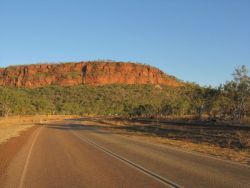 |
 |
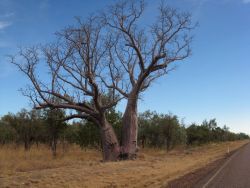 |
|
Victoria River Gorge. An amazing backdrop to the highway between Katherine and Kununurra |
The start of the real Kimberley scenery |
Baobab trees provided a continuous variety of shapes and sizes |
Ice creams in the middle of nowhere
As we headed slowly towards the WA border the temperatures began to climb. West of Timber Creek we reached the Saddle Creek rest area with the temperature getting on for the old century mark or 37 degrees, and with 118kms under the belt it seemed like a good place to rest. Luckily there was a table and chairs under some shade which came as a great relief after the tropical sun. We had just sat down, the sweat still dripping into our eyes, when a lady from the nearest caravan came over with two glasses of c-c-c-cold w-w-w-ater! Other than when we pulled into a town or roadhouse, we only had our water bottles to turn to for refreshment, and a mouthful of sun-warmed water is never enjoyable. This gift of cold refreshing H2O was more welcome than almost anything we could have imagined, and as we savoured the last few drops, she returned with two ice blocks!
Our eyes nearly popped out of our heads at the apparitions she carried over. To say that there has never been a better tasting ice block in the history of man would not be an exaggeration, well not from us anyway. We felt a little guilty when her husband admitted they were the last two ice blocks they had, but the guilt didn't stay long.
I’m sure the look on our faces confirmed to this kindly couple that their simple act of generosity in the middle of the hot dry dusty outback lifted our spirits enormously. We did run into them much later in the ride and we got the chance to offer our thanks again, and to this day that episode still stands out as one of the highlights of the ride.
Failure of the feast
Both the cycling guide books we had onboard offered sage advice that cyclists could benefit from WA’s strict quarantine laws at the border checkpoint, as many foodstuffs could not be taken over the border. We were advised that often there would be caravanners holed up in the rest area at the border post, sorting and unloading all manner of delicious fruit and vegetables that were not allowed into WA, and a canny cyclist could score an extra meal without having hauled the extra weight along.
As we ate our last banana and orange and took each others photo at the border sign, we scanned the rest area and environs for signs of life, but to no avail. To cut this short story even shorter, the only caravans we saw as we rode up to the checkpoint were already just about through the cursory checks by the officers, and although we waited briefly for the promised bonanza to arrive in the next wave of over-supplied mobile kitchens, none appeared and we regretfully passed through the checkpoint, stomachs rumbling, with two hours of pedalling ahead of us to reach Kununurra and some good solid paid-for food.
Apparent benefits of an iron fist
Throughout the ride we had attempted to respect and engage the indigenous folk we encountered but with little success, as we gained a distinct impression they were not in the slightest bit interested in engaging with us. In Katherine we would walk past and through large mobs sitting around, mostly drunk, and never making eye contact. We found out from Coco that the indigenous culture finds eye contact disrespectful. That said, we had no reason to try and engage with people who might not welcome our intrusion, so we left well enough alone. One thing I must stress is that at no time did we feel uncomfortable walking past and even through large groups of obviously drunk aborigines, who basically ignored us. I can’t say I feel the same about walking close to drunk bogans.
The first stop after Kununurra on our way southwards through the Kimberley was the Doon Doon roadhouse owned by the local community. As we sat around talking to the (European) managers of the roadhouse, several carloads from the local community arrived and bought supplies including toys for the kids who then ran around playing with each other, happy and active. As we expected they weren’t interested in engaging us and we respected that. We couldn’t fail to notivce, however, that there was a real sense of happiness and good health in all from the community, such a stark contrast to the listless and sometimes obstreperous mobs we had previously encountered. When we mentioned this amazing difference the managers told us that the head of the community was a rather strapping gentleman who enforced a zero alcohol policy from a position of strength and force of character.
If the happiness, good humour and robust good health of the community was solely due to the total exclusion of alcohol (and presumably other poisons) then I for one can see no problem with total alcohol bans enforced in a meaningful way in these indigenous communities. Well-meaning but pig-ignorant vocalising do-gooders from civil libertarian sectors can bleat all they like about racist discrimination but having seen the results at Doon Doon it’s obvious that sometimes the old saying you’ve got to be cruel to be kind is absolutely spot on.
Taking a stick to my bike
Virtually from the moment we left Canberra the issue of parking the bikes dominated so many moments of the ride. We had purchased expensive European double stands but the first decent gust of wind in Newcastle toppled my bike leaving a dent in the frame. Thereafter I tended to only use the side stand and it was often frustrating to try and get just the right slope on the ground to suit the weight and the angle of the stand. And on several occasions, when I thought I had it right, I would turn around to see the bike had fallen over anyway.
I thought I had developed a good system soon after leaving the east coast when I used a piece of truck tyre to rest the stand on, which prevented the leg from sinking into soft ground. Much searching of the roadsides produced a beautiful square piece of retread about the size of a hand that I carefully retained between stops. However by the time we reached the heat and dust of the Kimberley I was a bit over carrying my precious piece of rubber that occasionally still allowed the bike to fall.
At a rest stop near Turkey Creek I finally decided to do something about it and armed with the blade of my Leatherman set off into the bush to get me a forked stick that I could use as a ‘proper’ stand. Down near a creek I located a thicket of something that looked about right and I emerged with about a meter of straight fairly lightweight wood with a nice little fork on the end. Some quick testing and further cutting proved the worth of the stick and from then on I don’t think the bike fell over once due to the stand. The secret was to have point of support right up near the saddle post rather than only inches from the ground, which necessitated a much longer support. It was a bit of a pain each time we stopped to pull the stick off the trailer and poke it back under the elastic straps when we moved on, but nowhere near as frustrating as having the bike fall over as though it had a mind of its own!
Who pays the fuel
Speed limits in NT and WA were in the order of 110-130 km/hr however only a select few appeared to be keen to avail themselves of the higher speeds, most vehicles were content to tootle along at 100km/hr and spend the savings when they got to town. If we did see a rapidly approaching car it was almost guaranteed to be a government or mining company vehicle, and who pays the fuel bills? Not the driver.
The most extreme example was on a straight stretch of road not far from Halls Creek, Pete was fixing a puncture and I was under some shade when I heard a rapidly approaching vehicle and looked up to see a mining ute nearly sideways on the gentle bend at the end of the straight. As the ute went past I would hazard a guess it was doing 180+ km/hr, with a bearded driver in a safety vest at the wheel obviously concentrating but seemingly quite relaxed. The ute kept the same speed as it crossed a small bridge and then disappeared around the next bend. I was quite surprised not to hear any tyre squeal or other indication of the excessive speed.
I guess it’s possible that there was an emergency he was rushing to, but to me it looked like a case of someone who didn’t take too kindly to wasting an extra ten minutes driving responsibly at the end of the working day, cold beer was calling!
Freezing in the outback
We bush-camped between Turkey Creek and Halls Creek in a rest area, one of the best locations of the whole ride. The highway had been diverted for a couple of kilometres over a new bridge, and with rare foresight the authorities had left the old highway and bridge intact, and even installed some shelters with table and chairs.
With the distant sound of traffic competing with the jukebox of a bunch of rowdy miners further down the creek, it wasn’t quite the perfect camping spot but it wasn’t hard to get to sleep in the tents, with the last of the day’s warmth still drifting over from the empty road surface. Early in the morning, probably around 2am, I woke up to an unaccustomed feeling of being uncomfortably cold. No matter, I slipped on the thermal singlet and went back to sleep. An hour or so later I was disturbed again by the cold, so on went a few more layers and although cold, I drifted back to sleep. But once again, still well before dawn, the cold got to me and I rummaged around in the clothes pannier, put extra socks on the feet, a beanie on the noggin and laid the space blanket over the sleeping bag, but couldn’t get back to sleep.
We estimated the temperature dropped close to zero, because we were colder than when we camped at Bundanoon and the reported minimum there was 4 degrees. As we rode out of the river channel up to the level of the highway the temperature jumped at least 5 degrees, so abruptly I could almost feel my head emerge into it before my legs. It seems that although camping close to the riverbed was aesthetically pleasant, it meant that the cold air had pooled around us. We didn’t have a colder night until Ravensthorpe well past Perth.
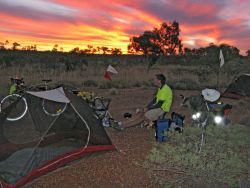 |
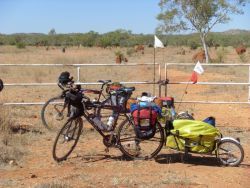 |
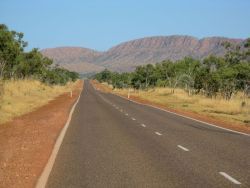 |
|
Another campsite in paradise a day's ride out of Halls Creek |
Giving the steeds a rest while we boil the billy |
In the middle of the Kimberleys with the beautiful purple hills |
Testing our limits
From Halls Creek to Fitzroy Crossing the distance is 290 kilometres, and there's literally nothing in the way of facilities in between except a couple of rest stops. We knew this, and had prepared for it, but it still represented the biggest single unknown of the trip. The distance itself didn't faze us, nor did the possibility of having to camp out twice. Water was the biggest issue, with only 6 x 1.5 litre PET bottles and two drink bottles each. We could have increased that by another 5 litres or so but we figured what we had would be enough, and with several dozen caravans passing us every day on the roads, if we did run out we could always 'borrow' a few litres to see us through to Fitzroy Crossing.
Food was my main concern, as we were finding that even with a good muesli start to each day, one bush camp with rice and tuna for dinner, and baked beans or similar for lunch just didn't provide enough petrol to supply the energy we needed. Up until this leg we had only had a maximum of two days and one night without a good hearty pub meal, and I was a little apprehensive about energy levels if we had to go the extra day.
In the end, and despite not leaving Halls Creek until 10am after waiting for the post office to open, we did 115 km the first day and 175 km the second day and pulled into Fitzroy Crossing with about a litre of water on board and not a lot of energy. I was forced to pedal some of the last 10 km with only one leg doing the work, for some reason when I applied pressure with the left foot it felt like a hot poker had been shoved behind my toes. I was glad that didn't happen with 50 kms or more to go!
As usual, within half an hour of arrival in Fitzroy Crossing, and a few ginger beers and flavoured milks under the belt, we regained most of the missing energy and all of a sudden life was good again!
Broome, touristy one day, expensive the next
We headed into Broome with high expectations that we had entered paradise but first impressions were not as good as hoped. By the same token, it was a nice clean modern town with what looked like good facilities. Initially we weren't even sure we could find accommodation as every single caravan park and other accommodation options were showing the FULL signs on the notice board at the tourist info centre. On a wing and a prayer we decided to try our luck at the caravan park closest to the city centre and bingo!, the nice lady at the counter said she knew exactly where to put bike riders like us. We were allocated a site on a narrow strip of green grass overlooking the water, which wasn't wide enough for car-dependant campers to use.
The camping fees were up there but not excessive, but elsewhere what we found was an economy that had grown fat off the back of the tourist dollars. Everything was expensive, from drinks to snacks to meals, which we didn't mind too much as we expected it to be up a bit. When we saw a sign at the backpackers for a curry and rice for $13.00 it seemed a good bet so we went in and ordered one each, and got a small plastic plate with a handful of rice and a spoonful of curry! Lesson learnt, nothing comes cheap in good old Broome town.
Next day we rode out to visit Cable Beach (I believe the fine for not visiting this iconic strip of sand while in Broome is substantial) and wandered the beach for a while and with little else to do went in search of lunch. Wandered up to the kiosky thing selling hot and cold tucker and had a squiz at the menu and we were not impressed. The only thing that looked like the kind of food for hungry bike riders was a hamburger... for $14.00! Well when in Broome pay the Broome prices was the order of the day, so we ordered one each. Now get this for stupidity, when the burgers were produced they were easily three times as big as a normal hamburger. Even with our bike-riding appetites we couldn't finish these monsters. The question still burns when I think of Cable Beach... why have such a huge burger at such a ridiculous price? Wouldn't it be better to have a $9.00 burger that people can finish?
Overall Broome was a nice place to visit with a reasonable number of attractions, including said Cable Beach which was good to relax on and walk out into the surf for 50 metres and still be only chest high in water, however the whole time we were there the wind blew from the east at up to 30-40 km/hr so the edge was certainly taken off the enjoyment just a little.
 |
 |
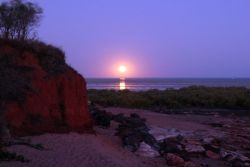 |
|
Campsite at Roebuck Plains Roadhouse, the last stop before Broome |
Cable Beach. The end of the 'away' kms. From hereon in all pedals were homeward-bound |
The world famous 'stairway
to the moon' in Broome. |
